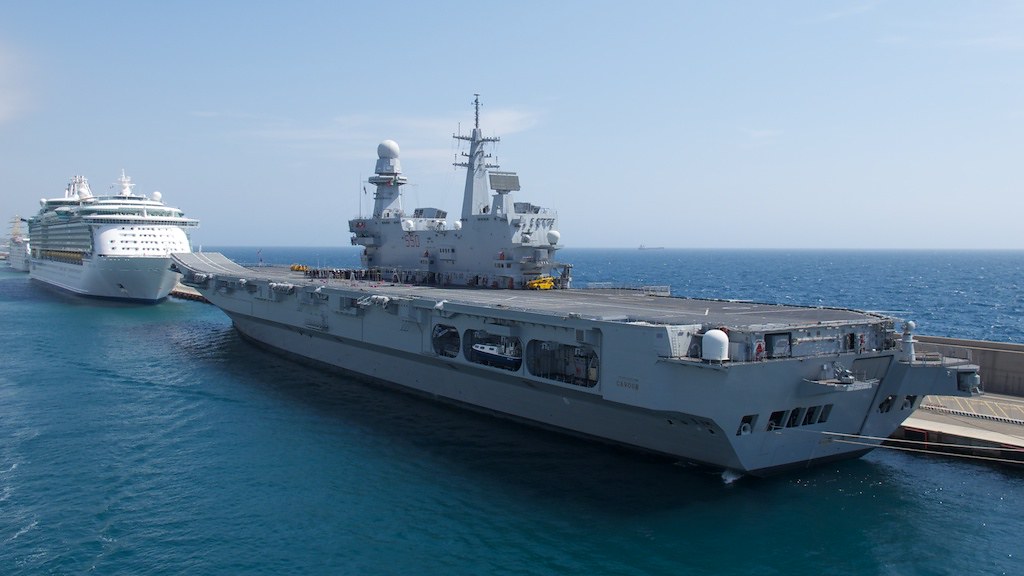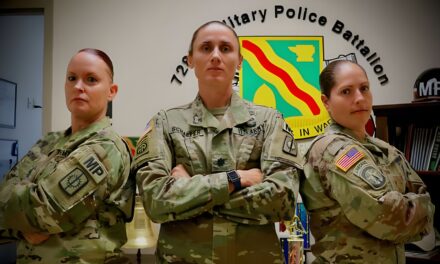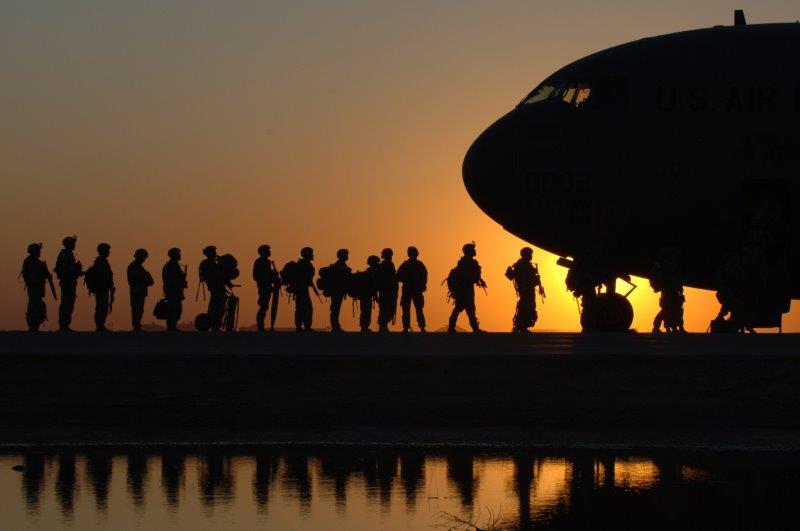The aircraft carrier vs cruise ship question comes up more than one would think. Aircraft carriers and cruise ships stand out when it comes to magnificent engineering marvels that rule the broad seas. Both are enormous in size and weigh a great deal, but they have very distinct functions. We shall contrast aircraft carriers with cruise ships in this article to examine the key differences between them in terms of size, function, construction, accommodations, power source, duty, and safety.
Aircraft Carrier vs Cruise Ship Key Takeaways
- Aircraft carriers and cruise ships are both large vessels, but serve vastly different purposes.
- Aircraft carriers are designed for military use, while cruise ships are used for commercial tourism.
- Aircraft carriers are often larger and more heavily armed, while cruise ships prioritize passenger experience and entertainment.
- Each vessel has unique construction and design features, power sources and propulsion systems, and safety and security measures implemented.
- The economic impact and role of tourism associated with each vessel also differ.
Key Differences in Vessel Size Dimension and Purpose
Cruise ships and aircraft carriers are both ocean giants, though they serve different purposes and have very different sizes. An aircraft carrier's main job is to act as a mobile base for military aircraft such fighter jets and helicopters. In contrast, a cruise ship is built for pleasure and offers travelers a floating hotel experience.
Massive boats, aircraft carriers are typically 800-1000 feet long and over 100,000 tons in weight. Extreme weather, tremendous speeds, and the impact of aircraft takeoffs and landings are all things they are designed to withstand. The passenger capacity of cruise ships, on the other hand, is typically higher than that of aircraft carriers, with a normal length of 1000–1200 feet and a weight of 100,000–220,000 tons.
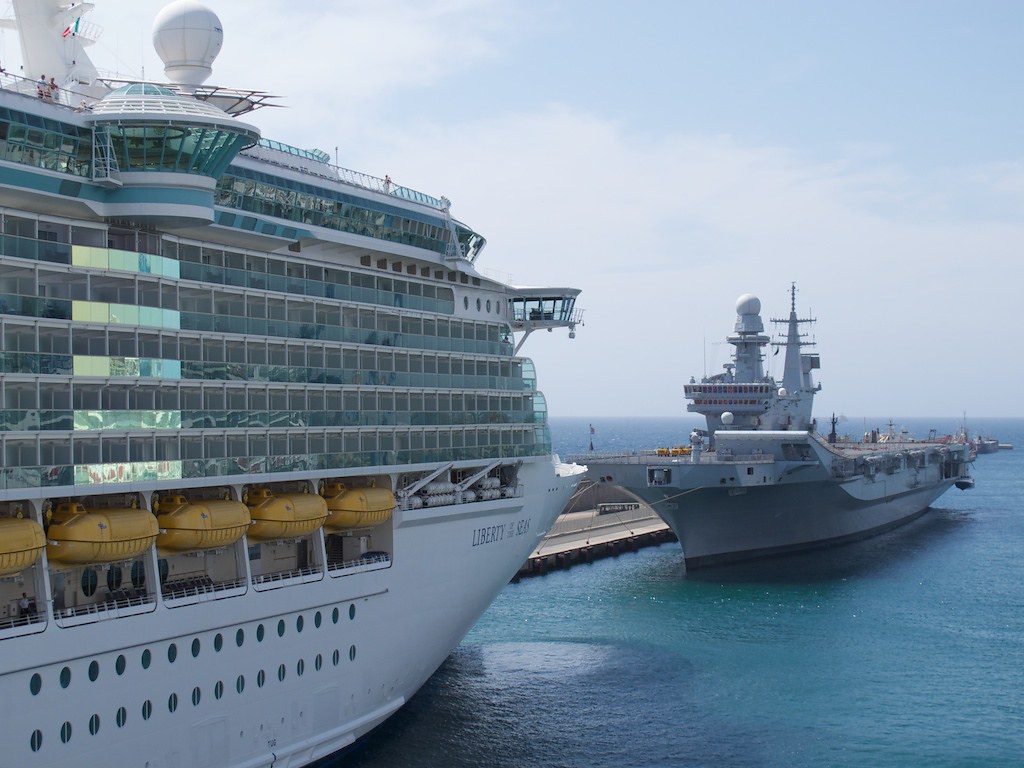
Both types of vessels exhibit some similarities in their layout and features, while being made for quite distinct reasons. For instance, both ships include various decks, dining rooms, and entertainment facilities to keep passengers and crew happy and comfortable.
Key Differences in Size and Purpose:
| Aircraft Carrier | Cruise Ship | |
|---|---|---|
| Length | 800-1000 feet | 1000-1200 feet |
| Weight | over 100,000 tons | 100,000-220,000 tons |
| Purpose | Mobile airbase for fighter jets and other military aircraft | Leisurely floating hotel for vacationers |
Construction and Design Features
The structure and features of cruise ships and aircraft carriers are very different. Although both ships are built to survive the hardships of ocean travel, their respective missions and operating needs necessitate special design elements.
Fighter jets, helicopters, and other types of aircraft can be launched from and recovered by aircraft carriers, which are vessels designed expressly for naval combat. As a result, they have enormous flight decks for operating aircraft and are made to fit big air squadrons.
Did you know: The flight deck of a typical navy aircraft carrier is designed with a special heat-resistant coating to withstand the extreme temperatures generated by jet engines during takeoffs and landings?
Contrarily, cruise ships are recreational craft designed for the comfort and enjoyment of passengers. As a result, they give priority to features like restaurants, spas, theaters, and swimming pools. Additionally, specific design components for stability and agility, including bow thrusters and stabilizers, are needed for cruise ships.
Another notable difference is in their shape - aircraft carriers have a flat, streamlined deck with no protruding features to minimize wind resistance and maximize speed, while cruise ships are characterized by their towering, vertical superstructures that house passenger cabins and facilities.
Materials and Structural Integrity
To endure the enormous strains of ocean travel, both aircraft carriers and cruise ships are built with cutting-edge engineering and high-strength materials. In order to restrict the spread of damage in the case of an assault or accident, aircraft carriers are constructed with reinforced steel hulls and compartments. This is because aircraft carriers, in particular, are subjected to enormous loads and impact forces that might harm the ship's structural integrity.
Advanced materials like steel and aluminum are also used in the construction of cruise ships, although passenger safety and comfort are given priority. To assure passenger safety at all times, cruise ships, for instance, include cutting-edge navigational systems, fire suppression and detection systems, and emergency response protocols.
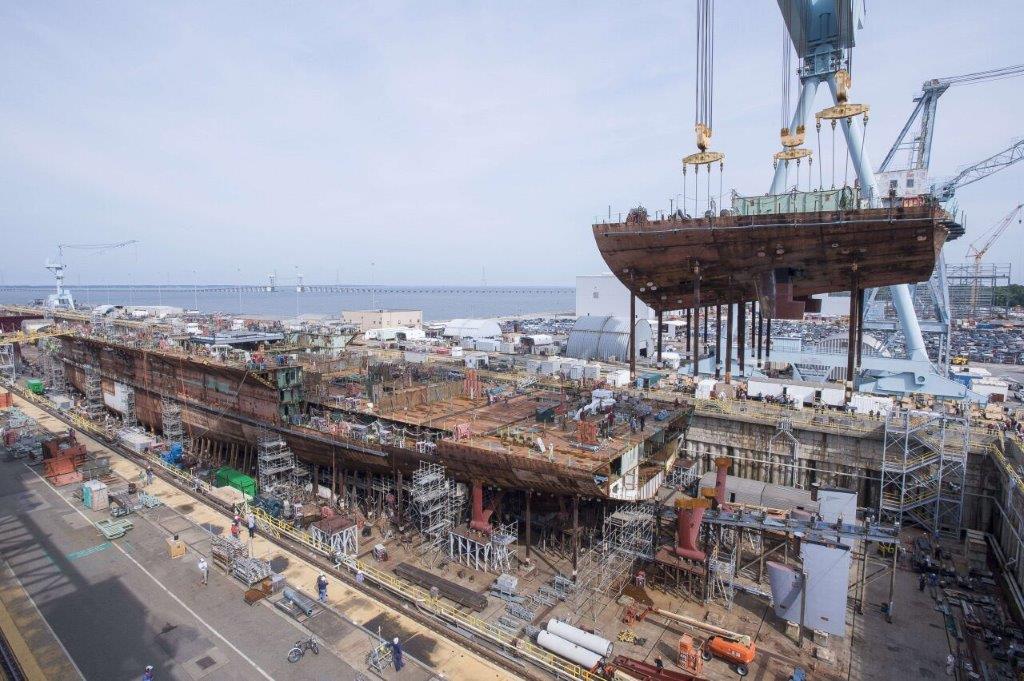
"An aircraft carrier is not built, it is grown." Admiral Hyman Rickover, father of the nuclear navy
In the end, the construction and design elements of aircraft carriers and cruise ships are different, reflecting the special functions and operational demands of each. While both boats are works of modern engineering, their designs and construction materials give priority to distinct aspects of ocean travel, with cruise liners focusing on passenger comfort and safety and aircraft carriers on military combat.
Accommodation Capacity and Passenger Experience
The ability of aircraft carriers and cruise ships to carry passengers is one of the most important distinctions. With little room and few amenities for passengers, aircraft carriers are primarily built to act as mobile airfields for military operations. Cruise ships, in contrast, are designed for comfort and relaxation, giving its guests a pleasant trip.
While cruise ships offer opulent cabins with all the conveniences of a five-star hotel, aircraft carriers have barracks-style lodging. On a cruise ship, passengers may often enjoy fine meals, entertainment options, and a variety of leisure pursuits including spas and swimming pools.
Aircraft carriers have a finite amount of room since they need to accommodate both military people and aircraft. For instance, the USS Gerald R. Ford can carry nearly 4,500 crew members but can only fit a few hundred more passengers. Modern cruise ships, like the Oasis-class ships from Royal Caribbean, may carry nearly 5,000 guests in addition to the crew.
| Feature | Aircraft Carrier | Cruise Ship |
|---|---|---|
| Accommodation Type | Barracks-style accommodations | Luxurious cabins with all amenities |
| Accommodation Capacity | Limited due to the need for aircraft and military personnel space allocation | Can accommodate thousands of passengers in addition to crew |
| Passenger Experience | Primarily designed for military operations, limited passenger amenities | Offers gourmet dining, entertainment, and recreational activities for passengers |
Overall, while aircraft carriers and cruise ships share similarities in their oceanic capabilities, the different purposes of each vessel result in vastly different accommodation capacities and passenger experiences.
Power Source and Propulsion Systems
Power sources and propulsion systems aboard aircraft carriers and cruise ships are very different. Nuclear reactors are used to power aircraft carriers while diesel engines are often used on cruise ships. The aircraft carriers can run for extended periods of time without refueling because to the nuclear reactors' nearly limitless power supply. In contrast, cruise ship diesel engines need constant fueling and maintenance to operate at their best.
On an aircraft carrier nuclear reactors power the steam turbines and propellers used by aircraft carriers. Azipods, which are electrically propelled pods with 360-degree rotation, are used by cruise ships instead of propellers to provide more mobility. Azipods also offer the benefit of lowering noise and vibration levels, giving passengers a calmer and more comfortable journey.
Depending on their intended usage, cruise ships and aircraft carriers require different types of electricity and propulsion. The nuclear reactors on aircraft carriers give them the power they need to run and support the aircraft that are on board. Engines that are dependable, fuel-efficient, and capable of giving passengers a comfortable experience are needed for cruise ships. Both kinds of boats, however, need regular upkeep and attention to ensure their functionality and safety.
While nuclear reactors are more expensive to build and maintain than conventional engines, they offer several advantages, including long-range capability, silent operation, and reduced emissions. Cruise ships are increasingly using hybrid propulsion systems that combine diesel engines with electric motors. This can help to improve fuel efficiency and reduce emissions.
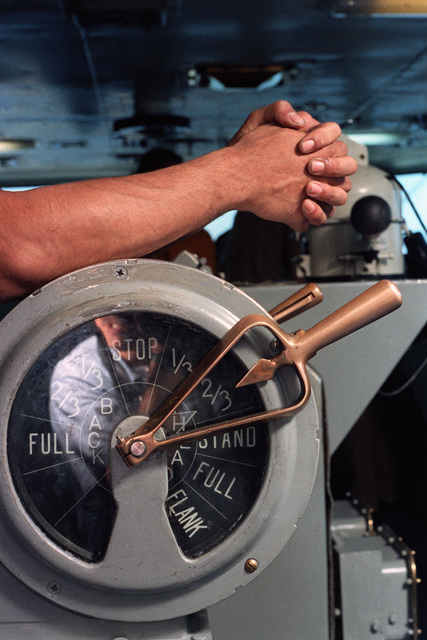
Role in the Navy and Commercial Sectors
In the military and private sectors, aircraft carriers and cruise ships play quite distinct roles. Aircraft carriers, the biggest and most potent warships in naval fleets, are built to support a variety of activities and act as mobile bases for military aircraft. They are able to project force across the oceans because they can carry a large number of fighter jets, helicopters, and other aircraft.
However, cruise ships are mostly employed for business-related activities like travel and tourism. They offer a wide range of services, including restaurants, entertainment venues, and recreational facilities, and are designed to carry thousands of passengers.
While national governments own and manage aircraft carriers, private firms typically own and manage cruise liners, which are part of the global tourist industry.
The Role of Aircraft Carriers in the Military
Modern warfare relies heavily on aircraft carriers to project naval force and assist military operations in the air. They are employed in a range of tasks, such as military operations, peacekeeping duties, and humanitarian aid initiatives.
Aircraft carriers can support surface ships and ground forces during combat operations by unleashing airstrikes against hostile targets and fending off approaching dangers. Additionally, they function as command and control hubs for coordinating military actions over great distances.
Aircraft carriers can be employed for a number of tasks in times of peace, such as humanitarian aid operations and international displays of force. Additionally, they convey military might and showcase a country's naval prowess as a deterrent to potential foes.
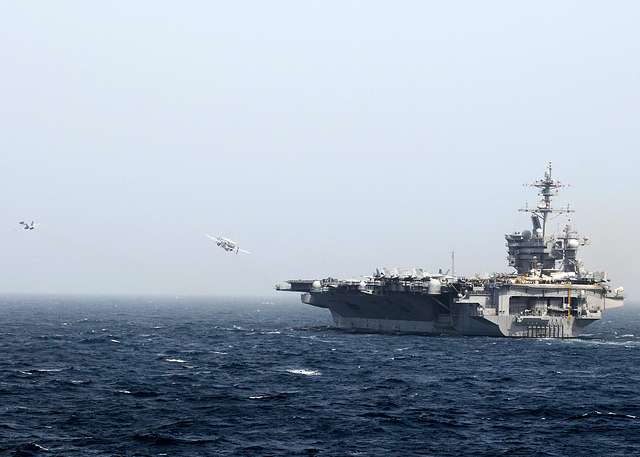
The Role of Cruise Ships in the Commercial Sector
Cruise ships transport passengers across the oceans of the world and offer a variety of amenities and entertainment alternatives. They are largely utilized for commercial purposes. They are owned and run by private businesses in the global tourism sector and bring in billions of dollars annually.
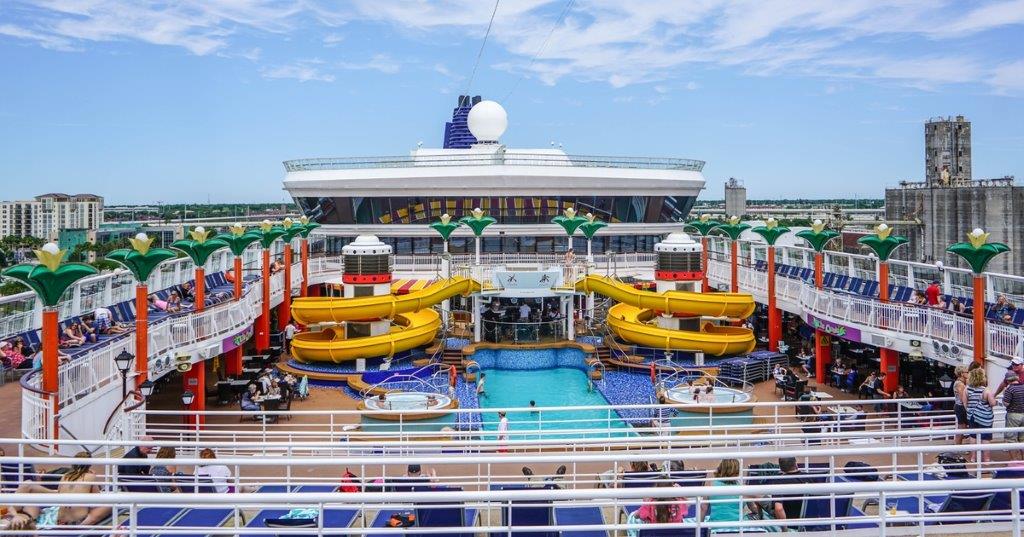
From exquisite dining and nightlife to onboard shopping and leisure activities, cruise ships provide a variety of activities and attractions. Additionally, many cruise ships include shore excursions so that travelers can experience well-known cities and tourist hotspots all around the world.
Additionally, cruise ships are a significant employer, giving thousands of people jobs in a variety of sectors, including hospitality, entertainment, and transportation.
Notable Examples of Bigger Aircraft Carriers and Cruise Ships
Both aircraft carriers and cruise ships have their fair share of impressive vessels. Here are some notable examples:
| Aircraft Carrier | Country | Commissioned | Image |
|---|---|---|---|
| USS Gerald R. Ford | United States | 2017 | 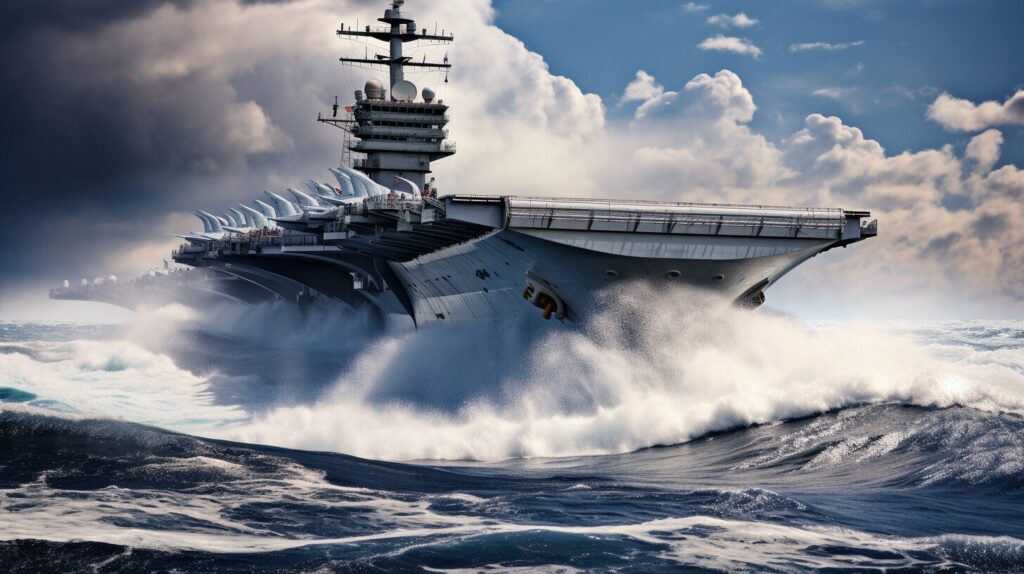 |
| INS Vikrant | India | 2022 | 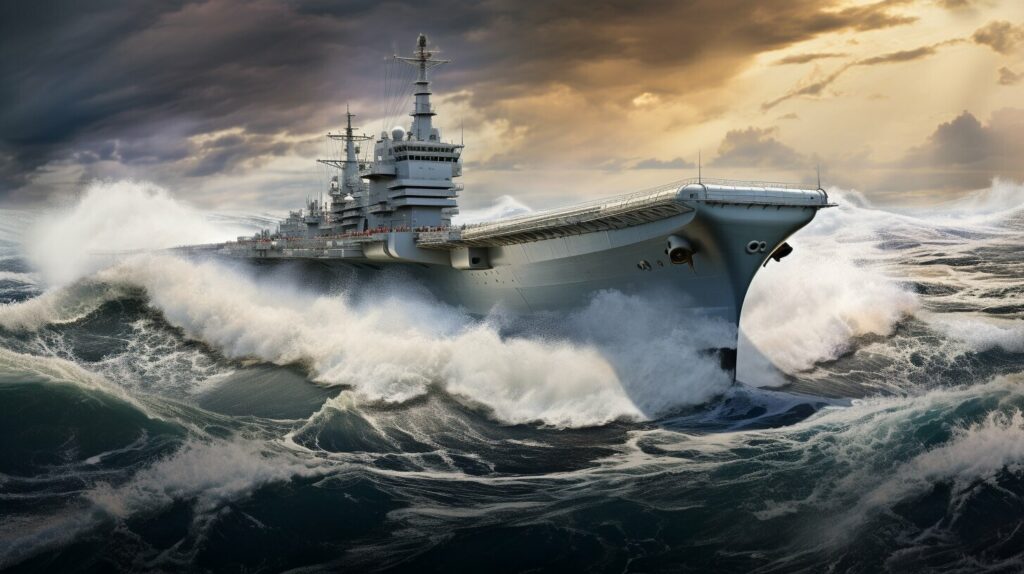 |
| Admiral Kuznetsov | Russia | 1991 |  |
| Cruise Ship | Company | Year Built | Image |
|---|---|---|---|
| Oasis of the Seas | Royal Caribbean International | 2009 | 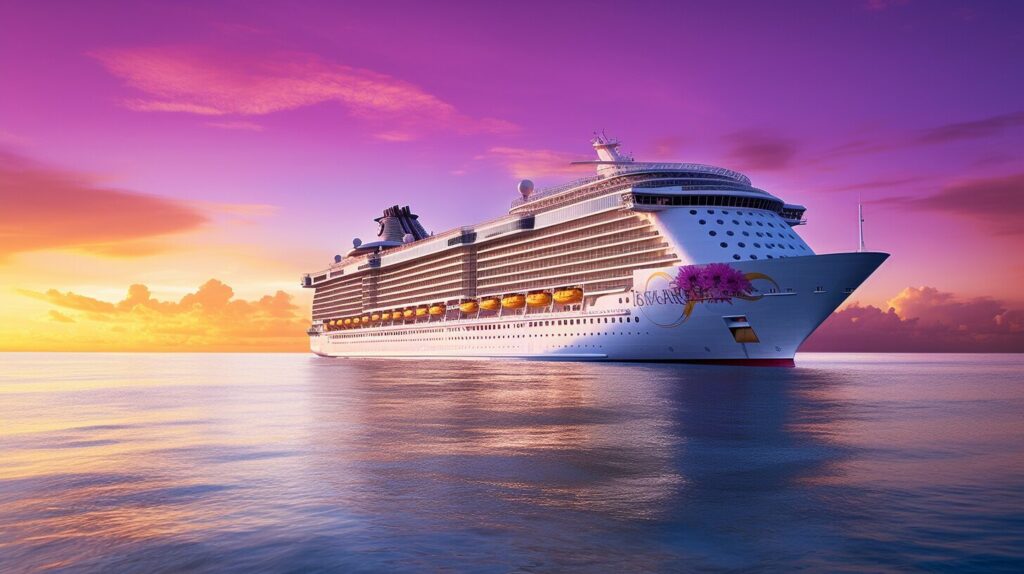 |
| Queen Mary 2 | Cunard Line | 2004 |  |
| Harmony of the Seas | Royal Caribbean International | 2016 |  |
The USS Gerald R. Ford is the most expensive and most technologically advanced aircraft carrier ever built, while the INS Vikrant will be the first aircraft carrier built in India. The Admiral Kuznetsovi s a steam-powered aircraft carrier and is Russia's only aircraft carrier and was recently involved in a fire while undergoing repairs. The Admiral Kuznetsov is the oldest aircraft carrier still deployed and in service.
Also interesting is Japan's JS Kaga (DDH-184), which is a helicopter carrier being converted into an aircraft carrier since beginning in March 2022. The ship is the second of the Izumo class, and is similar in size to the USS Gerald R. Ford. However, it is not nuclear-powered, and will be able to carry up to 28 aircraft, including the F-35B Joint Strike Fighter. The conversion of the JS Kaga is a significant development, as it marks the first time that Japan has converted a helicopter carrier into an aircraft carrier since World War II.
On the cruise ship side, Royal Caribbean International's Oasis of the Seas was the world's largest cruise ship when it debuted in 2009. Cunard Line's Queen Mary 2 is famous for its transatlantic crossings and luxury amenities. Royal Caribbean International's Harmony of the Seas is the world's largest cruise ship by passenger capacity.
Performance and Speed at Sea
The performance and speed capabilities of aircraft carriers and cruise ships are very dissimilar. While aircraft carriers are constructed for speed and agility to efficiently carry out military missions, cruise ships are built for leisurely vacation.
A cruise ship's top speed is 22–24 knots (41–44 km/h), but an aircraft carrier can typically go at 30-35 knots (55–65 km/h). Due to their different purposes, cruise ships prioritize luxury over speed, whereas aircraft carriers must be able to move swiftly to defend against potential attacks.
As previously stated, performance-wise, aircraft carriers are equipped with highly sophisticated propulsion systems, such as nuclear reactors, steam turbines, and gas turbines, that enable them to maintain high speeds for prolonged periods of time without refueling. On the other hand, cruise ships generally use diesel-powered engines.
The USS Gerald R. Ford, the newest aircraft carrier in the US Navy, is a great illustration of a ship with outstanding performance and speed capabilities. With two nuclear reactors, it has an operating lifespan of more than 20 years without refueling and a top speed of more than 30 knots (56 km/h).
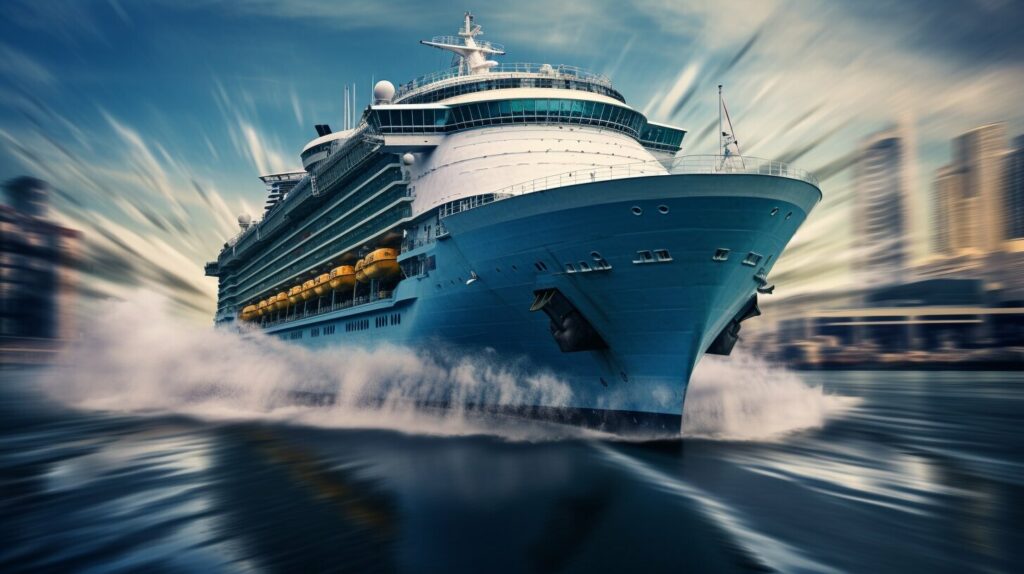
While both cruise ships and aircraft carriers have distinct benefits and capabilities, there are substantial disparities in their performance and speed that are a reflection of their contrasting roles in military and commercial travel.
Economic Impact and Tourism
The economies of the nations and ports that aircraft carriers and cruise ships visit are significantly impacted by their size and scope. Although aircraft carriers are primarily used for military purposes, the crew and support staff that travel with them can have an impact on the local economy.
On the other hand, cruise ships directly affect the regional economies of the ports they visit. According to a survey by the Cruise Lines International Association, the cruise industry had a $154 billion global economic impact in 2018 and supported more than 1.17 million employment throughout the globe.
Additionally, both cruise ships and aircraft carriers are crucial to the tourism sector. These enormous ships are frequently visited and explored by tourists, which enhances the whole tourism experience. In reality, a few cruise lines provide excursions that feature visits to retired aircraft carriers.
However, the COVID-19 pandemic has had an effect on the tourism sector, with numerous nations barring their ports to cruise liners. With cruise companies establishing tight health and safety procedures, the sector is gradually rebounding. However, it is impossible to overstate the economic contribution and significance of both cruise ships and aircraft carriers to the travel and tourism sector.
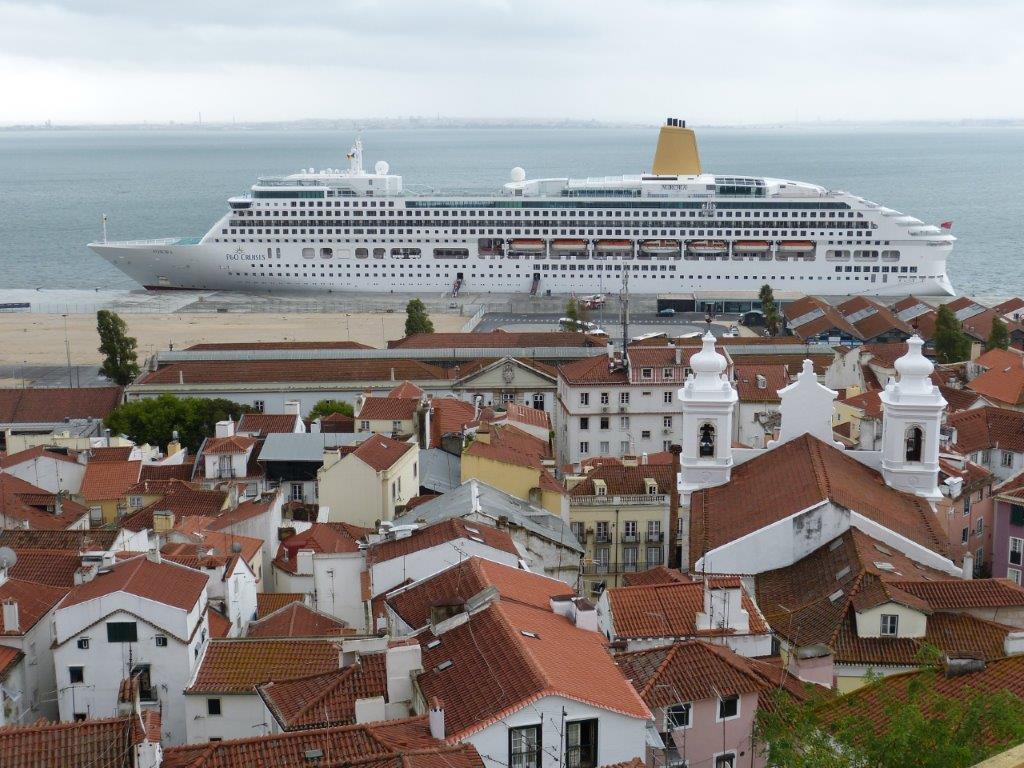
"The cruise industry is a vital part of the American economy. It generates billions of dollars in revenue and supports hundreds of thousands of jobs." - Cruise Lines International Association
Safety and Security Measures
To protect the well being of their passengers and crew, aircraft carriers and cruise ships both undertake strict safety and security procedures.
Due to the risky nature of military operations, safety protocols are given considerable importance on aircraft carriers. These boats have cutting-edge fire suppression systems, emergency evacuation strategies, and sophisticated radar systems to spot possible threats. The crew members also receive comprehensive training in safety practices, such as first aid, damage management, and firefighting.
The security and safety of the crew and guests are also top priorities on cruise ships. Numerous safety precautions, including lifeboats, fire suppression systems, and cutting-edge navigational equipment, are included on these vessels. Closed-circuit television (CCTV) systems and security staff are also provided on modern cruise ships to keep an eye out for any potential security risks.
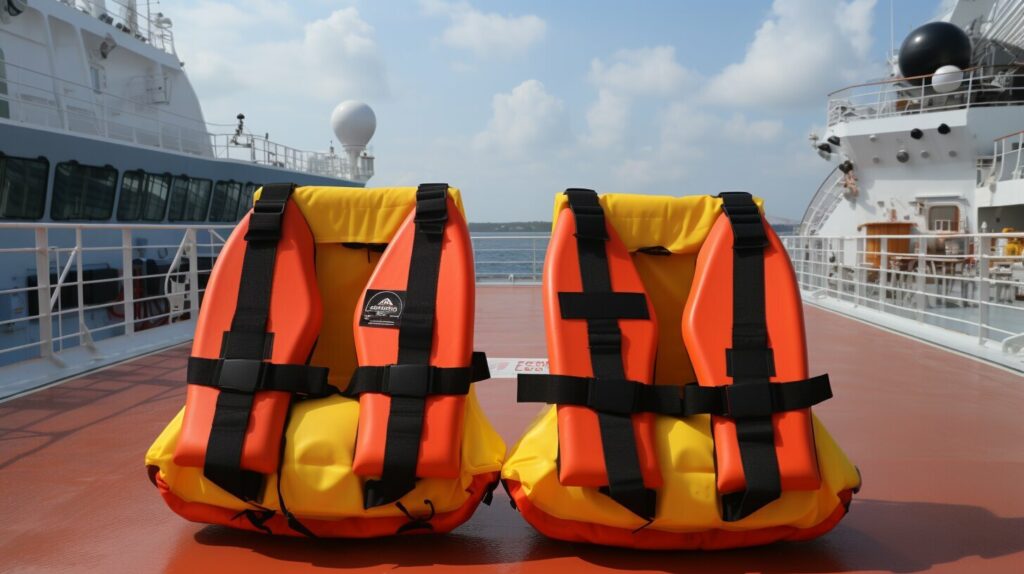
The respective evacuation procedures on aircraft carriers and cruise ships are a fundamental distinction between the safety precautions on each. While emergency evacuation routes and protocols for the crew are set down by aircraft carriers, cruise ships must take into account the vast number of passengers that are present. As a result, cruise ships frequently contain a number of muster stations where visitors must attend a safety training and get familiar with the ship's evacuation procedure.
Spreading of Outbreak and Disease
Aircraft carriers have a much lower incidence of norovirus outbreaks than cruise ships. This is because aircraft carriers have a more tightly controlled environment, with fewer people coming and going from the ship. Aircraft carriers have a number of measures in place to prevent the spread of norovirus, including:
- Strict hygiene procedures for food preparation and handling
- Frequent cleaning and disinfection of surfaces
- Screening of passengers and crew members for symptoms of illness
- Quarantining of people who are sick
These measures have been very effective in preventing norovirus outbreaks on aircraft carriers. In fact, there have been only a handful of norovirus outbreaks on aircraft carriers in the past few decades.
Did You Know: Norovirus is a highly contagious virus that causes vomiting and diarrhea. It is the leading cause of gastroenteritis outbreaks on cruise ships. The virus can be spread through contact with contaminated food, water, or surfaces. It can also be spread through person-to-person contact
Cruise ships, on the other hand, have a more difficult time preventing the spread of norovirus. This is because they have a much more open environment, with passengers and crew members coming and going from the ship all the time. It is also more difficult to enforce strict hygiene procedures on cruise ships, as there are simply too many people to monitor.
As a result, cruise ships are more susceptible to norovirus outbreaks than aircraft carriers. In fact, there have been a number of major norovirus outbreaks on cruise ships in recent years, including one in 2019 that affected over 500 people on the Royal Caribbean International.
Wrapping Up Cruise Ships vs Aircraft Carriers
In conclusion, even though cruise ships and aircraft carriers are both ocean monsters, their functions are completely different. Military aircraft carriers are created and constructed primarily to support naval operations with air power. Cruise ships, on the other hand, were created and built for profit, particularly to offer travelers opulent lodging and entertainment.
They differ in many ways than merely size and intended function. There are significant variations between the two in terms of structure and design, sleeping capacity and passenger experience, power source and propulsion systems, performance and speed, as well as safety and security measures.
Despite their distinctions, cruise ships and aircraft carriers both have large economic effects and are in charge of producing a sizable amount of tourism money. They both serve as examples of contemporary engineering wonders, even if their motivations for doing so are extremely different.
FAQ
Q: What is the difference between an aircraft carrier and a cruise ship?
A: A cruise ship is a passenger ship used for entertainment and leisure travel, whereas an aircraft carrier is a sizable military vessel built to carry and launch military aircraft.
Q: How do aircraft carriers and cruise ships differ in size and purpose?
A: Aircraft carriers are developed for military purposes, primarily for launching and retrieving aircraft, and are substantially larger than cruise ships. Cruise ships are made to accommodate and amuse those traveling for fun.
Q: What are some notable examples of aircraft carriers and cruise ships?
A: The USS Gerald R. Ford and the USS Nimitz are two notable aircraft carriers. The Oasis-class ships from Royal Caribbean and the Carnival Vista are both well-liked cruise ships.
Q: What power sources and propulsion systems are used by aircraft carriers and cruise ships?
A: Nuclear reactors are commonly used to power aircraft carriers, while diesel engines or hybrid electric-diesel propulsion systems are more common aboard cruise ships.
Q: How do aircraft carriers and cruise ships differ in terms of accommodation capacity?
A: Aircraft carriers have a restricted capacity for crew personnel and are mostly utilized for military activities. On the other hand, cruise ships have a variety of cabin types and facilities and are built to carry a big number of guests.
Q: What roles do aircraft carriers play in the military and cruise ships in the commercial sector?
A: Aircraft carriers are essential to military operations because they act as mobile air bases and help militaries project their might internationally. On the other hand, cruise ships are primarily used for leisure travel and offer passengers entertainment and recreational activities.
Q: How do aircraft carriers and cruise ships impact the economy and tourism?
A: Aircraft carriers have a big economic impact since they help the defense sector and create jobs. Through tourism, cruise ships support local economies by generating income from port fees and passenger spending.
Q: What safety and security measures are implemented on aircraft carriers and cruise ships?
A: A variety of security precautions are in place on both aircraft carriers and cruise ships, which prioritize safety. However, due to their military nature, aircraft carriers have stricter security procedures.

